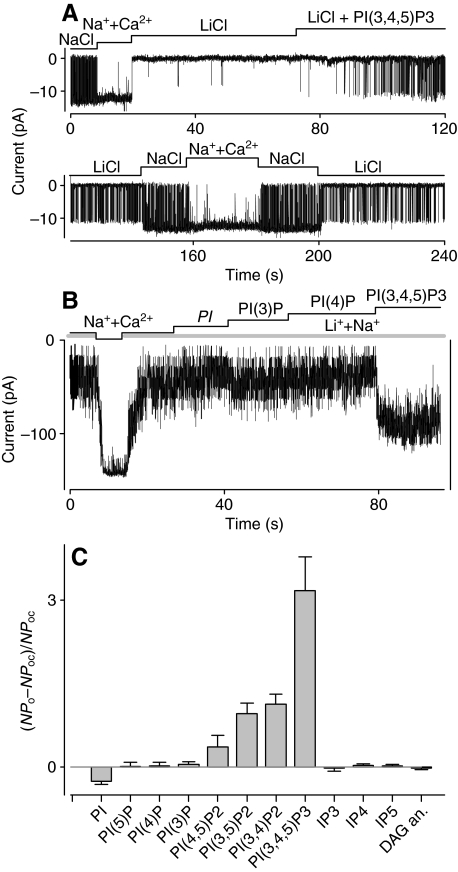Fig. 1.
The lobster sodium-gated cation (SGC) channel can be activated and modulated by exogenous lipids in inside-out membrane patches. (A) Current traces of a channel activated by exogenous phosphatidylinositol 3,4,5-trisphosphate [PI(3,4,5)P3, 16 μmol l−1]. Holding potential, −70 mV. Electrode solution: NaCl (210 mmol l−1) + Ca2+ (10 nmol l−1). Bar above current traces shows time course of solution application. LiCl: LiCl (210 mmol l−1) + Ca2+ (10 nmol l−1). NaCl: NaCl (210 mmol l−1) + Ca2+ (10 nmol l−1). Na++Ca2+: NaCl (210 mmol l−1) + Ca2+ (100 μmol l−1). Note: exogenous PI(3,4,5)P3 (1,2-dipalmitoyl analog was used in the experiment) activates the channel independently of intracellular sodium and calcium. Both current traces are gap-free recordings from the same patch. (B) Multi-channel activity in another patch exposed to Na++Ca2+ and different PIs (20 μmol l−1) in the presence of 180 mmol l−1 Li+ and 30 mmol l−1 Na+ (Li++Na+). Holding potential, −60 mV. Electrode solution: NaCl (210 mmol l−1) + Ca2+ (10 nmol l−1). Bar above current traces shows time course of solution application. Note: PI(3,4,5)P3 greatly increased the channel open probability in the presence of 30 mmol l−1 Na+ whereas phosphatidylinositol (PI), PI(3)P and PI(4)P were ineffective. (C) Bar diagram of the relative efficacy of various PIs, a diacylglycerol (DAG) analog and inositol phosphates (IPs) on the SGC channel in membrane patches excised from cultured lobster olfactory receptor neurons (ORNs). Efficacy was calculated as (NPo–NPoc)/NPoc, where N is the number of channels, Poc is the channel open probability in control conditions (Li++Na+) and Po is the channel open probability in Li++Na+ and 20 μmol l−1 of one of the following: PI (n=5), PI(3)P (n=5), PI(4)P (n=5), PI(5)P (n=4), PI(4,5)P2 (n=4), PI(3,5)P2 (n=4), PI(3,4)P2 (n=3), PI(3,4,5)P3 (n=9) or 1-oleoyl-2-acetyl-sn-glycerol (DAG analog, 10 μmol l−1, n=7), IP3 (3–10 μmol l−1, n=8), IP4 (5–20 μmol l−1, n=15) and IP5 (10 μmol l−1, n=5). Note: PI(3,4,5)P3 is the most effective lipid.

